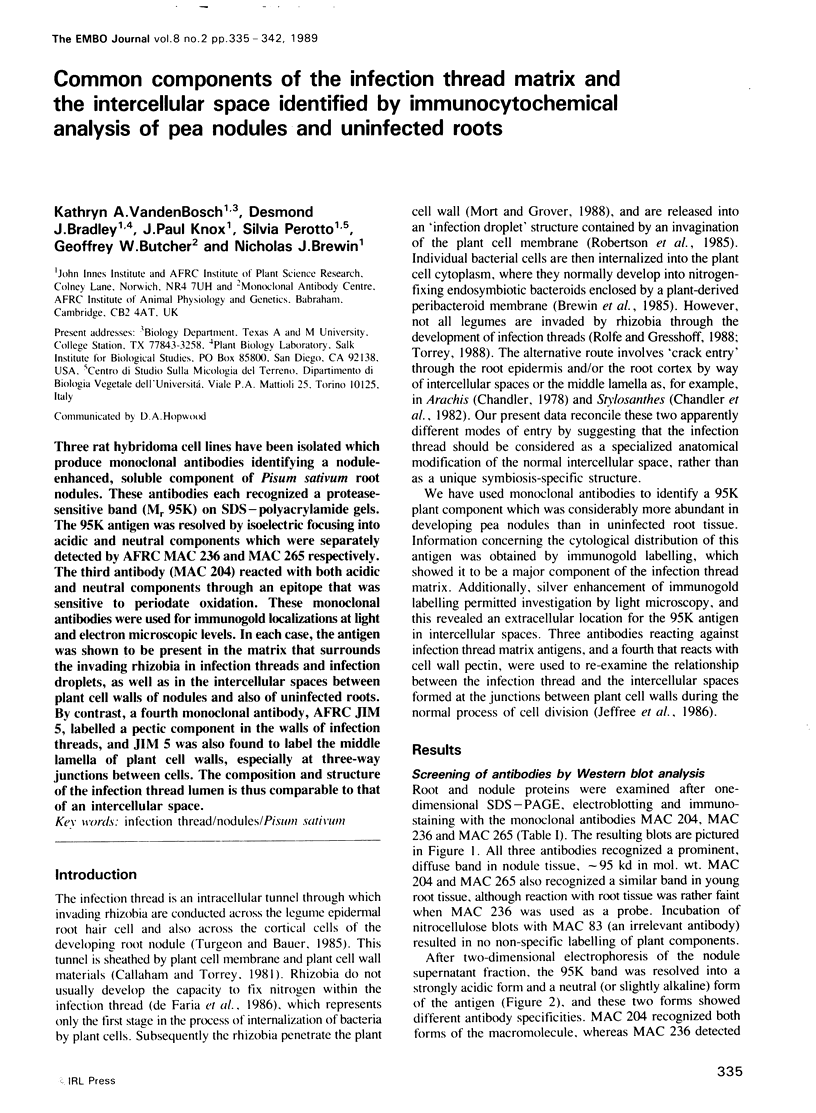Abstract
Three rat hybridoma cell lines have been isolated which produce monoclonal antibodies identifying a noduleenhanced, soluble component of Pisum sativum root nodules. These antibodies each recognized a protease-sensitive band (Mr 95K) on SDS-polyacrylamide gels. The 95K antigen was resolved by isoelectric focusing into acidic and neutral components which were separately detected by AFRC MAC 236 and MAC 265 respectively. The third antibody (MAC 204) reacted with both acidic and neutral components through an epitope that was sensitive to periodate oxidation. These monoclonal antibodies were used for immunogold localizations at light and electron microscopic levels. In each case, the antigen was shown to be present in the matrix that surrounds the invading rhizobia in infection threads and infection droplets, as well as in the intercellular spaces between plant cell walls of nodules and also of uninfected roots. By contrast, a fourth monoclonal antibody, AFRC JIM 5, labelled a pectic component in the walls of infection threads, and JIM 5 was also found to label the middle lamella of plant cell walls, especially at three-way junctions between cells. The composition and structure of the infection thread lumen is thus comparable to that of an intercellular space.
Keywords: infection thread, nodules, Pisum sativum
Full text
PDF






Images in this article
Selected References
These references are in PubMed. This may not be the complete list of references from this article.
- Bittner M., Kupferer P., Morris C. F. Electrophoretic transfer of proteins and nucleic acids from slab gels to diazobenzyloxymethyl cellulose or nitrocellulose sheets. Anal Biochem. 1980 Mar 1;102(2):459–471. doi: 10.1016/0003-2697(80)90182-7. [DOI] [PubMed] [Google Scholar]
- Brewin N. J., Robertson J. G., Wood E. A., Wells B., Larkins A. P., Galfre G., Butcher G. W. Monoclonal antibodies to antigens in the peribacteroid membrane from Rhizobium-induced root nodules of pea cross-react with plasma membranes and Golgi bodies. EMBO J. 1985 Mar;4(3):605–611. doi: 10.1002/j.1460-2075.1985.tb03673.x. [DOI] [PMC free article] [PubMed] [Google Scholar]
- Galfrè G., Milstein C., Wright B. Rat x rat hybrid myelomas and a monoclonal anti-Fd portion of mouse IgG. Nature. 1979 Jan 11;277(5692):131–133. doi: 10.1038/277131a0. [DOI] [PubMed] [Google Scholar]
- Kyhse-Andersen J. Electroblotting of multiple gels: a simple apparatus without buffer tank for rapid transfer of proteins from polyacrylamide to nitrocellulose. J Biochem Biophys Methods. 1984 Dec;10(3-4):203–209. doi: 10.1016/0165-022x(84)90040-x. [DOI] [PubMed] [Google Scholar]
- Legocki R. P., Verma D. P. Identification of "nodule-specific" host proteins (nodoulins) involved in the development of rhizobium-legume symbiosis. Cell. 1980 May;20(1):153–163. doi: 10.1016/0092-8674(80)90243-3. [DOI] [PubMed] [Google Scholar]
- Mort A. J., Grover P. B. Characterization of root hair cell walls as potential barriers to the infection of plants by rhizobia : the carbohydrate component. Plant Physiol. 1988 Feb;86(2):638–641. doi: 10.1104/pp.86.2.638. [DOI] [PMC free article] [PubMed] [Google Scholar]
- O'Farrell P. H. High resolution two-dimensional electrophoresis of proteins. J Biol Chem. 1975 May 25;250(10):4007–4021. [PMC free article] [PubMed] [Google Scholar]
- Robertson J. G., Wells B., Brewin N. J., Wood E., Knight C. D., Downie J. A. The legume-Rhizobium symbiosis: a cell surface interaction. J Cell Sci Suppl. 1985;2:317–331. doi: 10.1242/jcs.1985.supplement_2.17. [DOI] [PubMed] [Google Scholar]









